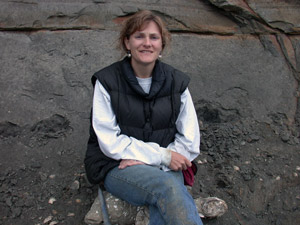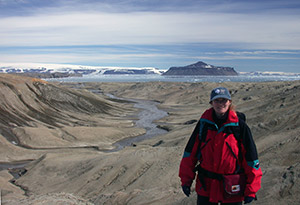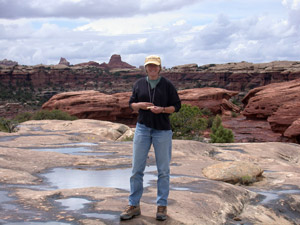 PaleoPeople
PaleoPeople
Linda Ivany
Syracuse University, NY, USA
— Interview conducted August, 2009
Dr. Linda Ivany is an Associate Professor at Syracuse University. She specializes in evolutionary paleoecology and paleoclimatology. She is a leading expert on stable isotopes in fossils and on the relationship between ancient climates and faunal change, and has been a Paleontological Society Distinguished Lecturer. Dr. Ivany sits on the Board of Trustees for the Paleontological Research Institution in Ithaca, NY. |
 A rare chilly day in the field in the Eocene of Alabama. Photo by Bruce Wilkinson. |
A: Fossils are cool! I was always interested in fossils and rocks, even as a little kid. When I was in 5th grade, one of my teachers at the Talcott Mountain Science Center, Rob Amrein, brought me outside and sat me down on a rock bigger than I was that he'd had brought to the Center, gave me a hammer and chisel, and literally said, "Have at … let me know what you find." Turned out it was a slab full of dinosaur tracks from the Connecticut rift valley! He of course knew this, but it was a huge thrill for me. Growing up in Connecticut, most of the rocks are metamorphic, so I had learned most things from books and museums. This was my first experience with real fossils, at least real old ones. After that, I started making my parents drive me to New York State to collect there!
Q: What is your specialty … your main interest?
A: I guess I'd say I'm broadly interested in how organisms relate to their environment. I've spent a lot of time working in the Eocene Epoch … a time when Earth went from being quite a bit warmer than it is today to the time when glaciers appeared on Antarctica. I'm interested in how shallow marine communities reacted, and you can use this as a proxy for today, which is basically the Eocene in reverse. I also use the chemistry of fossils to learn about the animals themselves and the environments in which they lived. It's pretty cool when you can learn how long a clam lived and how fast it grew 50 million years ago, and what the temperature of the water was like during its summers and winters.
Q: What are you currently researching?
A: For the past ten years I have been working in two areas: the Gulf Coast and Antarctica. In both of those places, I'm collecting fossils from shallow-marine shell beds to find out how ecosystems changed through time, and I'm looking at the chemistry of those fossils to see what the environment was like. The Gulf Coast has a spectacular sequence of Eocene rocks — very fossiliferous and beautifully preserved. I'm working on building a comprehensive record of temperature and faunal composition through the whole interval to look at the relationships among climate, ecology, and evolution. Antarctica also has an amazing Eocene sequence from a similar environmental setting, but at a much higher latitude. It's a neat system — the shallow marine communities today are unique, much like those of the Paleozoic, with stalked crinoids and other seemingly primitive organisms. The cold water temperatures exclude most predators, allowing those animals to live in habitats where they'd otherwise get eaten today. The early Eocene, when it was warm, had a fauna similar to that of the rest of today's oceans. But cooling during the Eocene eliminated some predators and initiated the transition to the weird ecosystem you see today. I'm interested in the effects global warming will have, and are already having, on the ecological character of Antarctic communities, as the prediction would be that you would run the Eocene in reverse and lose all these predation-sensitive animals.
I studied with Steve Gould at Harvard. Interactions among organisms, and between organisms and their environment, were not interesting to Steve. He was always pushing the "what does it mean for evolution" question. While that's not always the "main event" in the work I do, it's constantly there in the back of my mind, pushing me to think more broadly. That question motivates other work I've done with colleagues looking at the long-term evolutionary and ecological dynamics of fossil communities.
 Linda with early Paleogene sediments on Seymour Island, Antarctica, with the steep-sided Cockburn Island in the background. Photo by Dan Blake. |
Q: What is the most exciting or most interesting thing you've done in your career as a paleontologist?
A: Oh boy! Going to Antarctica … that was spectacular, both personally and scientifically!
Q: What is a "typical" day like for you?
A: [Laughing] Too short! On field days, which tend to be long, I eat and breathe paleontology. Antarctic field work is totally weather dependent. We have to sit in the tent all day when the weather is bad, but when it's good we can stay out forever because of the Austral summer. It becomes an issue of balancing scientific curiosity and excitement with the basic needs for sleep and food! The Gulf Coast is entirely different, because I get pretty worn down by the heat. By late afternoon, I'm ready to call it quits and get something cool to drink. I find it more exhausting than working in Antarctica, strangely.
At school I have to balance teaching, research, interacting with graduate students, and university service. I teach paleontology and introductory geology, along with assorted graduate classes. It's always fun to see how non-scientists in the intro class react to learning about paleontological topics. The K/T boundary is a great subject to cover because it's one of the best stories of scientific discovery out there. Teaching about evolution and Darwin is always interesting too. I cover the different lines of evidence for evolution and talk about the logic behind them. Some students don't quite get it — they may see a series of facts, but they can't or don't ask themselves, "what does it all mean?" For others, it's wonderful to see it all coming together in their heads. Some of them are really challenged by these ideas and have a hard time with them, and I respect them for wrestling with the facts and reconciling them with what they believe. That being said, I also commonly have two or three students — out of maybe 340 — who get up and walk out during those lectures.
 Linda in Canyonlands National Park, Utah, on a departmental field trip to the Colorado Plateau. Photo by Bruce Wilkinson. |
Q: What advice do you have for students, from kindergarten on up, who are interested in paleontology?
A: Most students will go through a geology program in college. Take any natural history classes you can. Take classes in biology, ecology, evolution, and chemistry. Beyond the standard geology coursework, these will give you the foundation you need to go on in the field. Math and statistics classes are also important, as they give you an important set of tools to draw on and help you think about data sets and what you can and can't say from them. For younger kids, go outside a lot. Look at the things in the natural world around you. Even if it's not looking at fossils, you can develop a real appreciation for the living world, and that's step one in paleontology. Museums are also great places to go to see cool things, and they can often help you find places nearby where you can go and collect fossils.
Q: Why is the study of fossils important in today's world? Is paleontology really relevant?
A: Paleontology is unique among the sciences because it can tell us about "The Pageant," as my advisor Steve Gould used to say — it paints the picture of the deep history of life on our planet. What did animals look like? What were they doing? How did they interact with their environment, and with each other? Because it is so inherently fascinating, it gets kids interested and excited about studying science. How cool is it that there were giant carnivorous lizards living in the oceans 100 million years ago? Or that tropical reefs used to be made out of clams, not corals? Or that there were five-foot-long sea scorpions with huge claws swimming around ripping things apart 400 million years before a human ever opened their eyes? With things like that, who needs science fiction?
Beyond the "wow" factor, paleontology is supremely relevant to what is going on today because it gives insight into how ecosystems will respond to a changing climate. Conditions on our planet have not been constant through its history — it has been warmer, cooler, wetter, drier, etc. on many occasions in the past. The fossil record tells us what happens to life when conditions change — who is most vulnerable and under what circumstances, and who is likely to do fine. As well, it provides context for what we see happening today, for example, extinction — are we really in the middle of a mass extinction? How can we tell? Are we the cause of that extinction? Studying paleontology is really the only way to put things into context. In so doing, it gives people an appreciation for life on Earth — both how fragile it is and how resilient it is.
Lastly, paleontology provides overwhelming evidence for the fact of evolution, that all life is connected by an unbroken sequence of ancestry and descent, with modifications along the way. Learning about the fossil record, and seeing all the evidence for why scientists know that evolution happens, provides a vehicle by which to teach students about science and about how to recognize and evaluate scientific arguments.